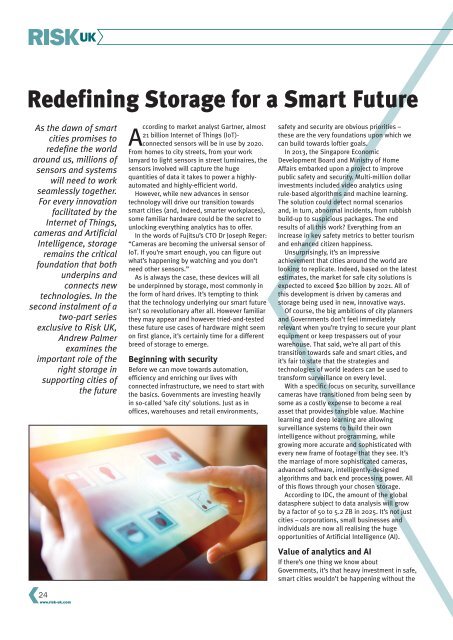RiskUKDecember2017
Create successful ePaper yourself
Turn your PDF publications into a flip-book with our unique Google optimized e-Paper software.
Redefining Storage for a Smart Future<br />
As the dawn of smart<br />
cities promises to<br />
redefine the world<br />
around us, millions of<br />
sensors and systems<br />
will need to work<br />
seamlessly together.<br />
For every innovation<br />
facilitated by the<br />
Internet of Things,<br />
cameras and Artificial<br />
Intelligence, storage<br />
remains the critical<br />
foundation that both<br />
underpins and<br />
connects new<br />
technologies. In the<br />
second instalment of a<br />
two-part series<br />
exclusive to Risk UK,<br />
Andrew Palmer<br />
examines the<br />
important role of the<br />
right storage in<br />
supporting cities of<br />
the future<br />
24<br />
www.risk-uk.com<br />
According to market analyst Gartner, almost<br />
21 billion Internet of Things (IoT)-<br />
connected sensors will be in use by 2020.<br />
From homes to city streets, from your work<br />
lanyard to light sensors in street luminaires, the<br />
sensors involved will capture the huge<br />
quantities of data it takes to power a highlyautomated<br />
and highly-efficient world.<br />
However, while new advances in sensor<br />
technology will drive our transition towards<br />
smart cities (and, indeed, smarter workplaces),<br />
some familiar hardware could be the secret to<br />
unlocking everything analytics has to offer.<br />
In the words of Fujitsu’s CTO Dr Joseph Reger:<br />
“Cameras are becoming the universal sensor of<br />
IoT. If you’re smart enough, you can figure out<br />
what’s happening by watching and you don’t<br />
need other sensors.”<br />
As is always the case, these devices will all<br />
be underpinned by storage, most commonly in<br />
the form of hard drives. It’s tempting to think<br />
that the technology underlying our smart future<br />
isn’t so revolutionary after all. However familiar<br />
they may appear and however tried-and-tested<br />
these future use cases of hardware might seem<br />
on first glance, it’s certainly time for a different<br />
breed of storage to emerge.<br />
Beginning with security<br />
Before we can move towards automation,<br />
efficiency and enriching our lives with<br />
connected infrastructure, we need to start with<br />
the basics. Governments are investing heavily<br />
in so-called ‘safe city’ solutions. Just as in<br />
offices, warehouses and retail environments,<br />
safety and security are obvious priorities –<br />
these are the very foundations upon which we<br />
can build towards loftier goals.<br />
In 2013, the Singapore Economic<br />
Development Board and Ministry of Home<br />
Affairs embarked upon a project to improve<br />
public safety and security. Multi-million dollar<br />
investments included video analytics using<br />
rule-based algorithms and machine learning.<br />
The solution could detect normal scenarios<br />
and, in turn, abnormal incidents, from rubbish<br />
build-up to suspicious packages. The end<br />
results of all this work? Everything from an<br />
increase in key safety metrics to better tourism<br />
and enhanced citizen happiness.<br />
Unsurprisingly, it’s an impressive<br />
achievement that cities around the world are<br />
looking to replicate. Indeed, based on the latest<br />
estimates, the market for safe city solutions is<br />
expected to exceed $20 billion by 2021. All of<br />
this development is driven by cameras and<br />
storage being used in new, innovative ways.<br />
Of course, the big ambitions of city planners<br />
and Governments don’t feel immediately<br />
relevant when you’re trying to secure your plant<br />
equipment or keep trespassers out of your<br />
warehouse. That said, we’re all part of this<br />
transition towards safe and smart cities, and<br />
it’s fair to state that the strategies and<br />
technologies of world leaders can be used to<br />
transform surveillance on every level.<br />
With a specific focus on security, surveillance<br />
cameras have transitioned from being seen by<br />
some as a costly expense to become a real<br />
asset that provides tangible value. Machine<br />
learning and deep learning are allowing<br />
surveillance systems to build their own<br />
intelligence without programming, while<br />
growing more accurate and sophisticated with<br />
every new frame of footage that they see. It’s<br />
the marriage of more sophisticated cameras,<br />
advanced software, intelligently-designed<br />
algorithms and back end processing power. All<br />
of this flows through your chosen storage.<br />
According to IDC, the amount of the global<br />
datasphere subject to data analysis will grow<br />
by a factor of 50 to 5.2 ZB in 2025. It’s not just<br />
cities – corporations, small businesses and<br />
individuals are now all realising the huge<br />
opportunities of Artificial Intelligence (AI).<br />
Value of analytics and AI<br />
If there’s one thing we know about<br />
Governments, it’s that heavy investment in safe,<br />
smart cities wouldn’t be happening without the

















